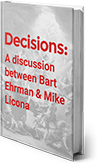Has the Family Tomb of Jesus Been Found?
On February 26, 2007, a team announced that they have discovered the family tomb of Jesus. In this article, Mike offers some preliminary thoughts.
Titanic movie director James Cameron, film documentarian Simcha Jacobovici and a few others announced that they had identified a tomb in East Talpiot (just south of the old city of Jerusalem) in which were discovered the skeletal remains of Jesus—son of Joseph and members of his family including,Mary (his mother), Mary (his wife from Magdalene), Jude (his son), Joseph (his brother), and another family member named Matthew. (The remains were contained in burial bone boxes called “ossuaries.”) The group also claims there is a strong probability that the James’ ossuary revealed in 2002 once sat in this tomb. The tomb under discussion was actually discovered in 1980 but little was thought of it until 1996 when the BBC aired a report suggesting that it may be the burial tomb of Jesus’ family, a claim that was dismissed by archaeologists and scholars. The recent news is that additional evidence has come to light through DNA testing.The book (you had to guess there would be one!) has just been released (The Jesus Family Tomb by Jacobovici and Pellegrino) and the television documentary The Lost Tomb airs on The Discovery Channel on March 6.
The ramifications of such a find—if true—would be devastating to the truth of Christianity. The apostle Paul wrote, “And if Christ has not been raised, your faith is worthless; you are still in your sins” (1 Corinthians 15:17). In the original Greek, Paul literally writes, “worthless your faith is,” placing the word “worthless” first in the clause for emphasis. If the bones of Jesus have been discovered, it is time for Christians to hang up their faith and go find something else in which to believe because we have been duped.
While I look forward to getting the entire story, there are 5 glaring problems that immediately surface with the suggestion that the tomb of Jesus’ family has been identified in Jerusalem .
1. The ossuaries are from the wrong location. 1st-century tradition places Jesus’ burial in Jerusalem by Joseph of Arimathea in a tomb that was discovered empty shortly thereafter. Even if one rejects the historicity of the resurrection of Jesus and posit that the body was instead moved by Jesus’ disciples, after one year his remains would have been placed in an ossuary and transported to their final burial. In those days, family members were normally buried in their hometown. In Jesus’ case, this would have been Galilee, not Jerusalem . So, if Jesus was not resurrected, we should be looking for his ossuary in Galilee . Moreover, the Talpiot Tomb does not square with other reports of where members of Jesus’ family were buried. Eusebius (4th-century, Ecc Hist. 2.23.18) reported that a stone marked the burial spot of James, Jesus’ brother, by the Temple Sanctuary in Jerusalem . The Talpiot tomb now being postulated is some distance away from where that spot would have been. According to tradition that goes back to the 6th-century, there are two traditional sites of Mary’s burial spot in Jerusalem —the Talpiot tomb isn’t one of them. It is also interesting to note that the traditional burial spots of James and Mary were all in different locations.
2. The collection of very popular names presented is unimpressive. Mary was the most common female name in Jesus’ day. In fact, there are at least six Mary’s in the New Testament.[1] Joseph was the second most common male name in Jesus’ day. Jude was the fourth most popular name and Matthew was the ninth. Of nearly 1,000 ossuaries that have been discovered in Jerusalem–I don’t know how many have inscriptions—22 have the name “Jesus” inscribed on them and two have “Jesus, son of Joseph.” Thus, to find six ossuaries with the names Jesus, Joseph, Mary, Mary, Jude, and Matthew has limited value. Moreover, one cannot ignore the fact that Matthew is among the bunch. If he wasn’t a son of Jesus, who was he? He was not listed as one of Jesus’ brothers. This terribly odd factor cannot be ignored by the sober historian. The documentary proposes that he was one of Mary’s ancestors, since there were 6 who could have been referred to as “Matthew” listed in Luke’s geneology between Mary and King David (Luke 3:23-31). However, the closest may have been Mary’s great-grandfather and we should ask why his remains are in the Talpiot Tomb while others weren’t. The documentary simply glosses over this ossuary that is grossly out of place.
3. There is strong historical evidence that Jesus was single: (a) In 1 Corinthians 9:5, Paul states that he and Barnabas have the same right to be married as others in their positions who are married; he then names Peter, the other apostles, and the Lord’s brothers. If Jesus had been married, Paul would only have to mention it and there would have been no need to mention the others; (b) In Acts 8:30-34, Phillip is talking to an officer in the Ethiopian Army—a eunuch—who was reading the writings of Isaiah while resting on his chariot. The passage he was reading said of the Messiah, “Who can speak of his descendants?”[2]—a question that would be especially interesting to a eunuch; (c) Although there were two Mary’s at Jesus’ cross (Jesus’ mother and Mary Magdalene), Jesus made provisions for his mother but none for the woman who was purportedly his wife? (d) There is no mention in the New Testament that Jesus was married. It is also noteworthy that there is not a shred of good evidence that Jesus was married or had children. The passage in the Gospel of Phillip, written 100-200 years after Jesus and to which Dan Brown referred in The Da Vinci Code, is preserved only in a single manuscript which contains holes that Brown conveniently supplied words for, making it appear that Jesus and Mary had a romantic relationship. In February 2005, I had a collegial television dialogue with Princeton professor Elaine Pagels on the Gospel of Thomas. During the break, moderator Lee Strobel asked us what we thought of Dan Brown’s assertion that Jesus was married to Mary Magdalene. Pagels, who is not at all sympathetic to evangelical Christianity, replied that Dan Brown is perhaps the only person in the world who believes that Jesus and Mary were married.With this new Talpiot Tomb proposal,Professor Pagels may now add a few more names to her list. The bottom line is that, if Jesus of Nazareth was single and had no descendants, the remains of those in the Talpiot tomb do not belong to him and his family.
4. Most importantly, the theory that the Talpiot tomb once contained the bones of Jesus and his family cannot explain other known historical facts. It is fairly certain that James became a Christian after the death of his brother Jesus and was serving as leader of the JerusalemChurch when Paul wrote Galatians between AD 49-55. The earliest proclamations of Paul, James, Peter, John, and the other Jerusalem apostles is that Jesus had been resurrected. In light of this, why would James, who was a pious Jew and who appears not to have been a follower of Jesus through the time of his crucifixion, help perpetrate the fraud that Jesus had resurrected when he knew where he was buried? Moreover, that shortly after his death by crucifixion Jesus’ disciples sincerely believed that he had resurrected and appeared to thembelongs to the historical bedrock that even most skeptical scholars regard as indisputable. The Talpiot tomb theory cannot explain this fact if these same disciples knew where the corpse of Jesus lay.
5. The DNA evidence establishes little. At best, it only links possible familial relationships between those in the Talpiot tomb. It cannot even suggest that the remains are those of the family of Jesus of Nazareth.
This new book and television documentary will be fascinating and appears at first look to be of a sensationalist genre. However, when this new Talpiot Tomb hypothesis is weighed in the historian’s scale, a few beans may be placed on the side in its favor while a brick of historical evidence is placed gently on the side against it. The tip of the scale that follows is not a gentle one.





